Of Notts Kennels by Her Grace, Duchess of Newcastle
Written by Maja Čosić
Proofreading by Sue Vasick
Article was published also as printed version in Borzoi Yearbook 2021/2022 (Europeanborzoi) and also in Croatian in Kennel Club magazine “Moj pas”:
https://online.fliphtml5.com/hxyvj/cxfx/#p=93
BONUS: Three pedigrees: Ivan Turgeneff, Petrosavodsk and Podar of Notts!
1.photo The Clumber mansion
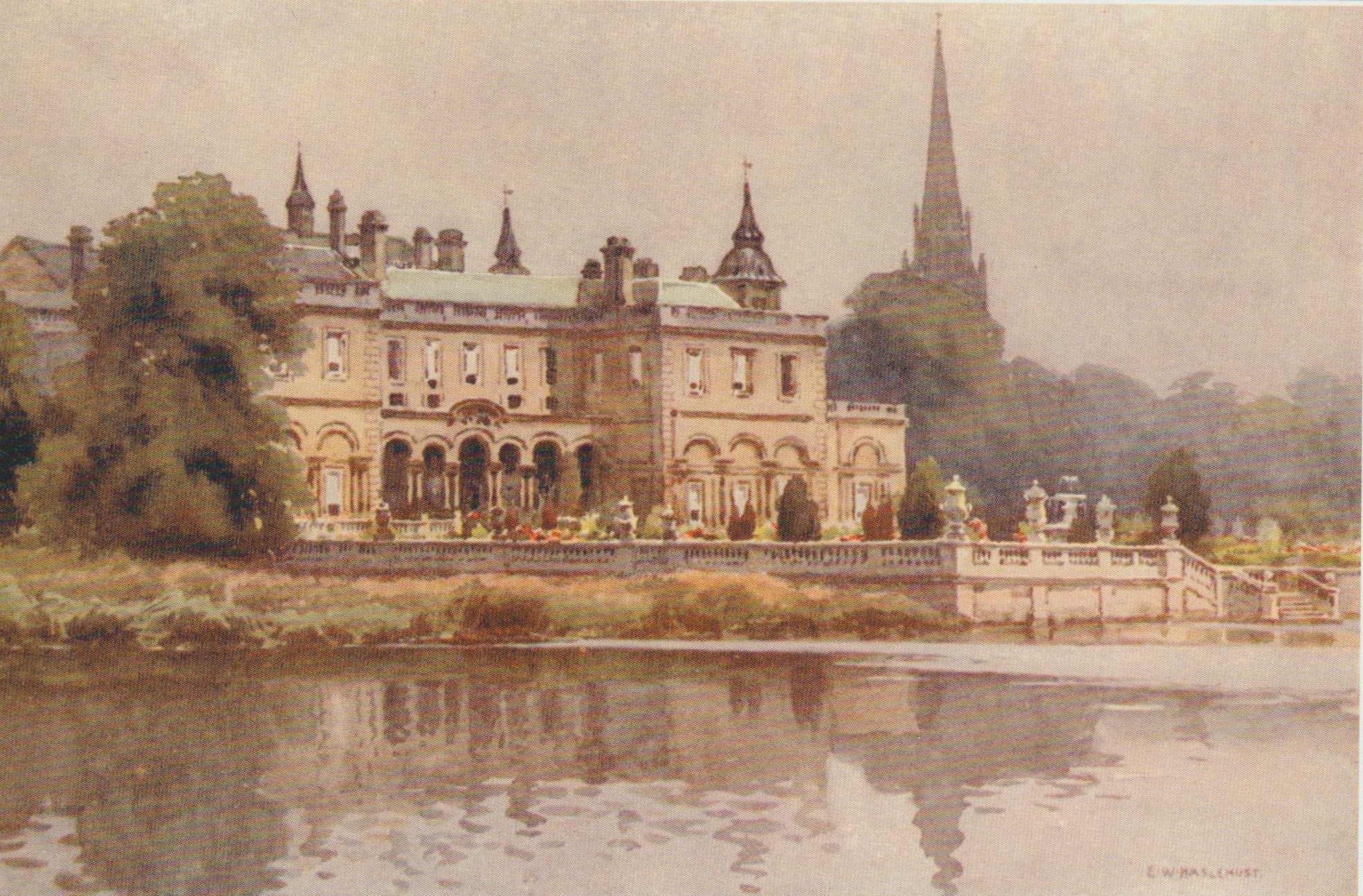
When someone mentions Nottingham or Sherwood Forest, the first things we think about are the Sheriff of Nottingham or the Legendof Robin Hood. But if you mention it to borzoi breeders, or to the breeders of fox terriers or clumber spaniels, they have another name on their mind: Kathleen Pelham – Clinton, Duchess of Newcastle, dog show judge and breeder. Owner of one of the biggest and most successful kennels of all times, kennel Of Notts, located in the heart of Nottingham near the Sherwood forest on the magical Clumber estate.
Kathleen Pelham – Clinton, Duchess of Newcastle was born on 1872 as Kathleen Candy. In 1889, at only 17 years of age she married Henry Pelham – Clinton, VII, the Duke of Newcastle. He was 24 at the time, so they became the youngest duke and duchess in England.
2.photo The Duchess and Duke of Newcastle, from archives of Sue Carter
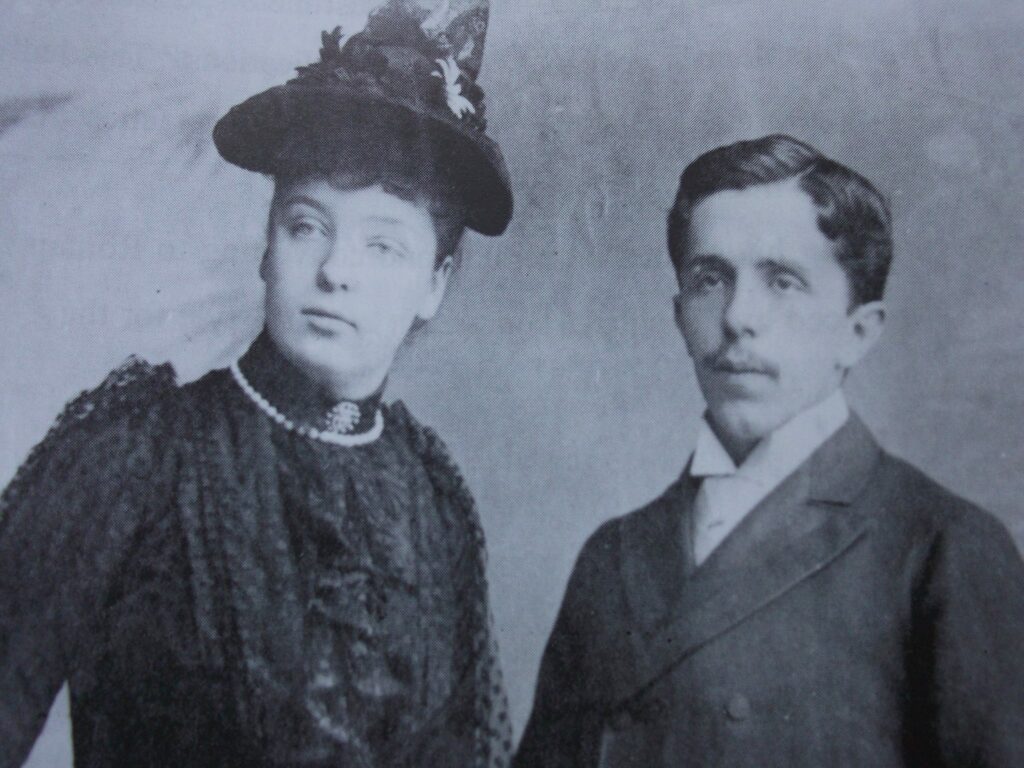
The Duke fell badly as a boy and injuredhis leg, which later caused many problems and pain, resulting in the needfor it to be amputated. Because of his short height, he gained the nickname „little duke“. All of this causedhim to be rather shy. The Duchess, on the contrary, was a very determined and open spirited woman whosuccessfullymanaged the Clumber estate.
The Duke and Duchess shared many of the same interests, one of them being dogs. In1892, they founded The Borzoi Club. The Duchess was President and Duke Co-President, with 12 board members who changed annually between the membership. The first meeting of the Club was in Abermale Hotel, Picadilly. The club name was protected by The Kennel Club, and membership fee was two guineas a year, one guinea for foreign members.
The Ladies Kennel Association was also founded, with Duchess as an important member. Her dedication to dogs was mentioned in many magazines and books.
In 1902 C. H. Lane dedicated a book,“Dog shows and Doggy People”, to the Duchess, and stated as follows:
TO HER GRACETHE DUCHESS OF NEWCASTLE
WHO, BY HER CONDESCENSION,PERSONAL PATRONAGE, AND SUPPORT,
HAS RAISED THE TONE OF DOG SHOWS
AND DONE MUCH FOR THE BENEFIT OF THE WHOLE DOGGY COMMUNITY
THIS BOOK IS MOST RESPECTFULLY DEDICATED BY THE
AUTHOR
THE CLUMBERESTATE
The Clumber estate belonged to the Clinton family, who had been granted with the Earls of Lincoln title in the 16th century. The title was borne by the Dukes of Newcastle-under-Lyme and eventually they added Pelham to their surname. Members of the dynasty made Clumber estate their home in the second half of the 18th century. The Clumber mansion was developed in 1760 as a ducal residence.
The coat of arms of the Dukes of Newcastle-under-Lyme shows two sighthounds holding the shield.
3.photo Dukes of Newcastle-under-Lyme’s coat of arms
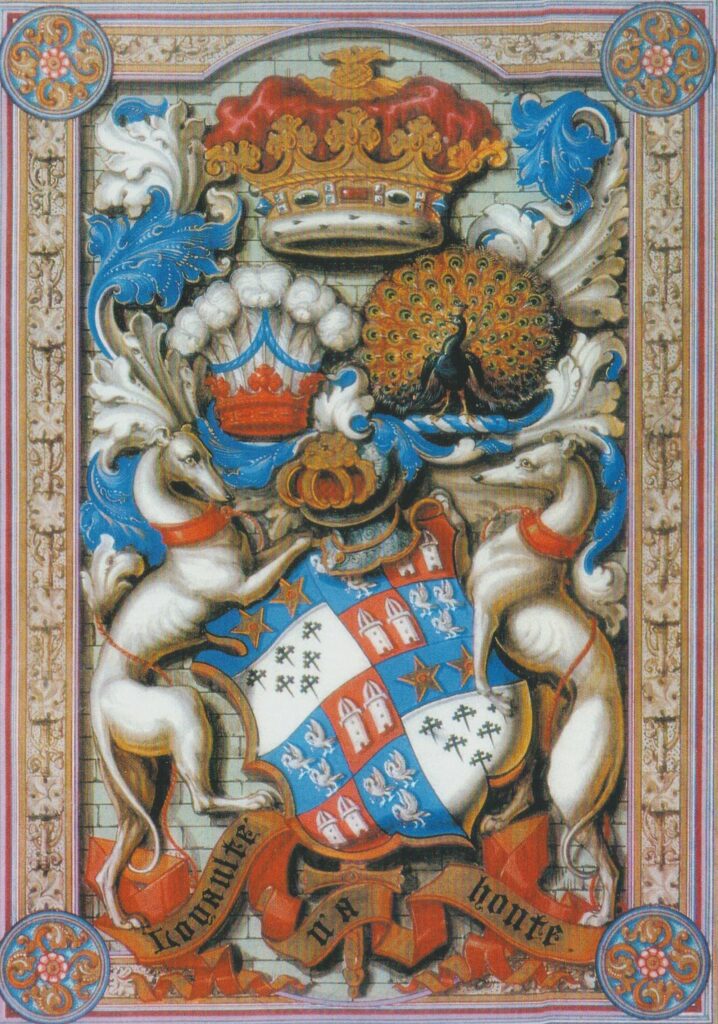
In 1879. after the passing of VI Duke of Newcastle, a fire broke on the estateand the castle suffered considerable damage. Fortunately, a settlement was achieved with the insurance company and the castle soon underwent a thorough renovation.
During the reconstruction, the rooms were renovated and the layout was changed. The new central atrium was 30 meters long, 13 meters wide and 15 meters high. Fortunately, the library was not destroyed in the fire. It was a real gem, containing very valuable collections with about 70.000 books, the oldest of which dated from 1481.
Among the paintings were valuable works by famous artists, even Rubens and Rembrandt. The house was decorated with tapestries, clocks, stuffed animals and whole collections made of glass and ebony. The most beautiful rooms were the crimson reception room, the smoking room with white marble figures, the room with the crimson chandelier and, by far the most alluring: the library. Interesting also was the oak room, decorated with a wooden carved fireplace with the coats of arms of the schools attended by the dukes. On each side of the fireplace were carved figures of two greyhounds facing each other.
In the spring of 1886, the reconstruction was completed and VII Duke moved to Clumber with his mother and siblings. After the wedding in 1889, his new wife, the Duchess, joined them.
The mansion was open to visitors whenever the family was not at home, which was quite often. Visitors could tour the rooms and walk through the park, and, in order to have a place to spend the night, a Greyhound hotel was built nearby.
The Estate was around 20 km wide and included the mansion, stables, storage buildings, gardens, park, forest and also the Hardwick village where the staff lived. The artificial lake was built on the Poulter River and was used as a romantic skating place in winter, while in summer it was adorned by the Duke’s yacht, Salamanca.
OF NOTTSKENNELS
4.photo View of kennels in Hardwick near Clumber with borzoi, around 1893.
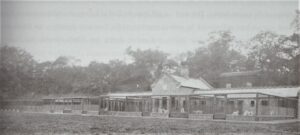
In 1891, the Duchess decided to build a kennel for her dogs in the village of Hardwick, not far from the castle. The kennels were designed according to her strict instructions and included a veterinary hospital. The kennels spread over 15 hectares of land. In the central building was a kitchen with storage; the fences were 2 or 3 meters high and separated the paved exercise area from the rest of the kennel.
There were several breeds in the kennel, mainly borzoi, fox terriers, deerhounds and whippets. The kennels could accommodate about a hundred dogs. During the 1896, it housed 30 borzoi, 25 fox terriers and 20 clumber spaniels. In the period from 1891 to 1904 more than 300 borzoi were bred and raised in these kennels.
Aside from the dogs, the kennels were home for one exotic animal:an American wolf, which was a gift from the Earl of Liverpool. This is not the strangest animal that has resided on the estate over the years as there are records that the IV Duke owned a leopard during late 1820., and his Trustees had two buffalos in the farm barn.
Clumber spaniels, the first breed on the estate
Clumber spaniels were bred on the estate since the mid-18th century. The French Count de Nouailles II presented the Duke of Newcastle with a couple of his spaniels during the French Revolution around 1760 – 1770. The breed continued to develop at the Clumber estate and soon gained its name after the location. Until the mid-19th century the breeding of the clumber spaniel was limited to the aristocracy. During the World War I. breeding was completely stopped, which resulted in a reduction in number of dogs. After the war, in 1925 King George V continued the breeding of clumber spaniels in the royal kennels of Sandringham.
Fox terriers, darlings of the Royal family
5.photo King Edward VII and his fox terrier Caesar circa 1908 © The Royal Collection Trust

The Duchess of Newcastle was president of The Wire Fox Terrier Association from 1916 to 1919 and a member until her death. Between 1900 and 1923, she bred twenty champions of this breed, the most successful of whom was the Cackler of Notts. He is considered the ancestor of all wire fox terriers in the world. Yet the most interesting of these dogs was his son Caesar of Notts, owned by King Edward VII. Caesar was bred by the Duchess and was the king’s favourite dog. He had his own valet and was allowed to sleep in an armchair next to the king’s bed. He wore a collar with the inscription I am Caesar. I belong to the King.
After the king’s death, Caesar did not eat for days,was hiding under the king’s bed, and howled inconsolably until he was recovered by the king’s widow,Alexandra. He achieved worldwide fame in 1910 when he joined the funeral procession of his master marching in front of state officials and nine kings, including future King George V.
6.photo Funeral of the King Edward VII with Caesar and Kings favourite horse © The Royal Collection Trust
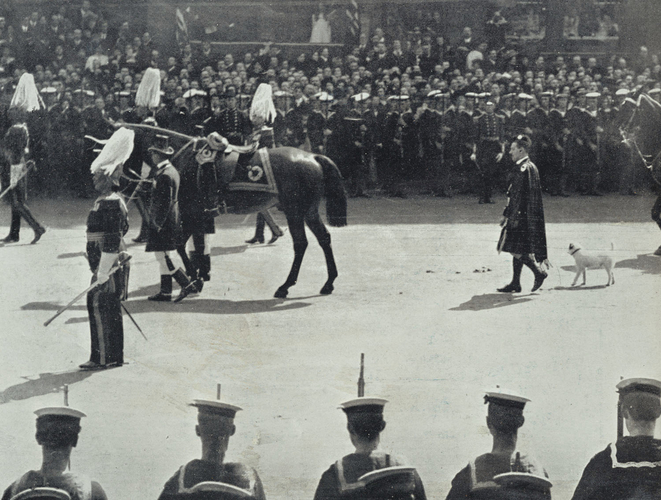
At the king’s tomb in the chapel of St. George in Windsor is a sculpture of Caesar curled up at the king’s feet. Caesar was buried along with Queen Alexandra’s other dogs in the dog cemetery in Marlborough Palace Park in London.
Alexandra was a breeder and exhibitor. She bred borzoi in royal kennels of Sandringham, and was one of the high society members often seen atdog shows, thus she was a friend of the Duchess. The most famous borzoi that belonged to the Queen Alexandra was Alix, a gift from the Russian Tsar Alexander II, her brother in law.
Borzoi, the inspiration of artist’s
The first record of borzoi in Britain is found in the early 19th century. The Duchess of Newcastle’s first encounter with Russian greyhounds was in 1886, when Marquis de Quadelmina presented her mother with a female borzoi he had brought from the Russian Imperial Kennels in Gatchina. They called the puppy Spain because the Marquis was aSpaniard.
Shortly afterwards, in 1889 the Duchess bought the male Ivan II, bred at the Paris Zoo. In the period from 1867 to 1914, a total of 41 litters of borzoi were bred in the Paris Zoo, together with many other breeds.
7.photoThe Duchess and Ivan II circa 1891.
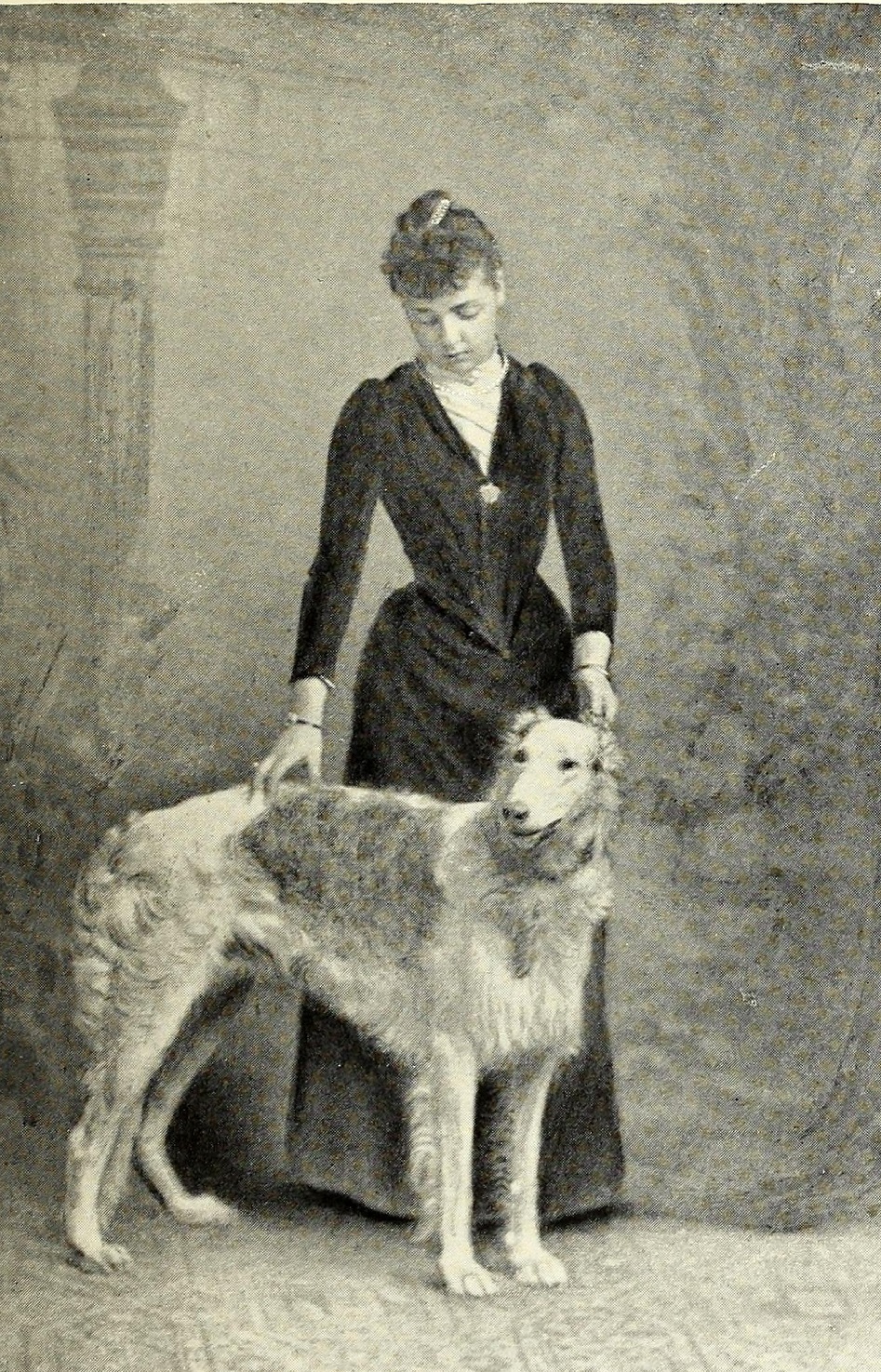
From the breeding between Ivan II and Spain eight puppies emerged. Soon followed the new imports from Russia and so began the serious breeding of borzoi at the Clumber estate.
8.photo Spain and her puppies,painting by Frank Watkins 1891 © Bonhams

The Duchess was one of the most important importers of borzoi from Russia into Britain. Sometimes she would send agents, or she travelled herself to Russia to select and redeem the best specimens. In 1891, one of her agents imported from St. Petersburg nine borzoi at once.
Grand Duke Nicholai Nikolaevich, the owner of famous Pershino kennel, advised the Duchess and passed his knowledge about borzoi to her.
After her visit to Russia and meeting with the Duke in 1891. she writes for the magazine Forest and Stream:
English judges will soon ruin this breed if they form a fresh standard; they will breed animals (not dogs) as top heavy and useless as present St. Bernard, simply through trying to make elephants of them. In Russia they do not consider height a point, simply symmetry of form and speed for hunting. The average height of dogs is from 16 to 18 vershoks (vershok is an old russianmeasure, and 16 to 18 vershoks equal 70 to 80 cm, or 28 to 31.5 inches); over this height they become coarse and lose symmetry and speed,which are much valued.
She also mentions the Duke in one of her articles for Our dogs magazine:
I flatter myself that I probably know more of His Imperial Highness the Grand Duke Nicholas Nikolaevich’s judgement of Borzoi than anyone else, as when I was in Russia, His Imperial Highness took the trouble to bring me Borzois, pictures and models, and explained all the points he most prized, he also gave me the picture of his best dog, a very beautiful and perfect specimen, and which type I try to keep in my mind’s-eye.
As to wolf hunting and killing, the Grand Duke told me that it was only a very exceptional dog that would tackle a wolf single handed, and that he himself judged a dog’s character and courage very much by the way he used his ears, and for this reason he laid great stress on ears, their carriage and movement. Usually two dogs are slipped at wolf, and when they have collared him the hunter comes up and kills the quarry.
Even then, the Duchess showed exceptional knowledge of borzoi breed, which will only deepen with her judging assignments that will follow.
FIRST WOMEN JUDGING AT DOG SHOWS
9.photo The Duchess judging fox terriers in the ring

10.dog show at the botanical garden in 1906, with the judge, Duchess of Newcastle (in black dress).
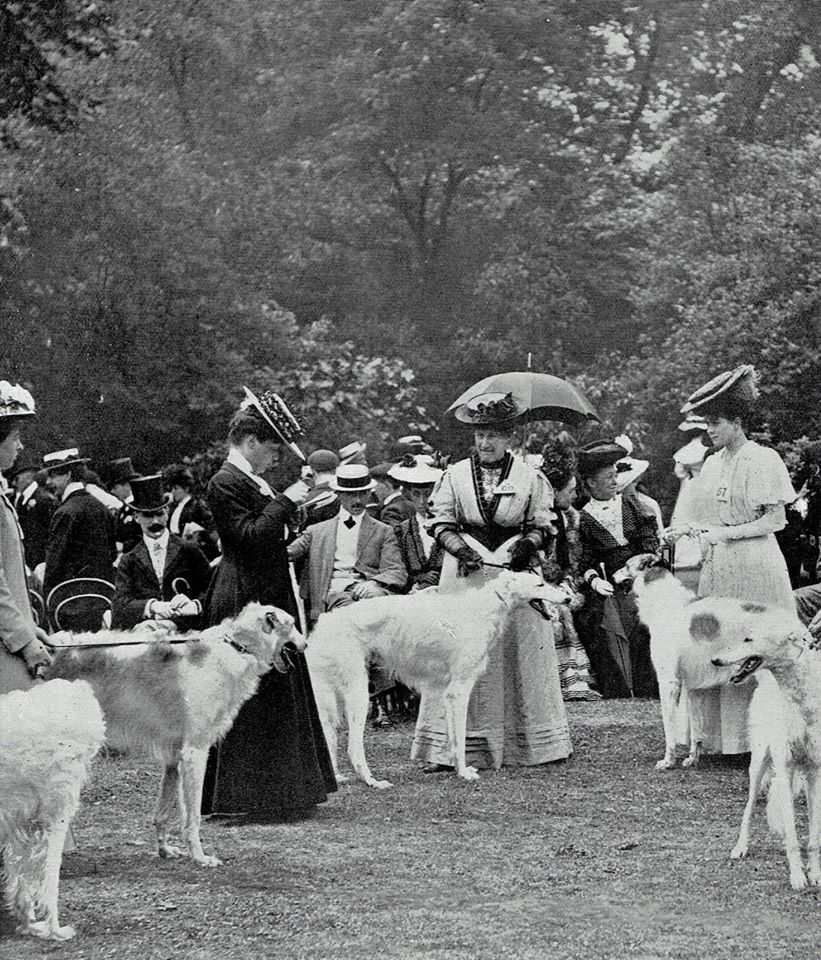
Mrs Whitney was first woman invited to judge at a dog show. That was in New York and she was judging St. Bernards. Mrs Holdsworth and Mrs Jenkins were first ladies to judge in England, and they judged Pugs and Toy Spaniels at the Maidstone show in 1886. Mrs Jagger was the first lady invited to judge big breeds. She judged St. Bernards in Belfast in 1894. and it caused a sensation at the time, the Press giving such headings as A lady going to the dogs, Advance of Woman, Innovation in Dog-judging etc.
Thus, the Duchess of Newcastle was not the first female judge, but she was very successful and at her first exhibition in Southport, Lancashire in 1897, she judged as many as 118 borzoi.
The canine literature writes about this event:
Her Grace, the Duchess of Newcastle has consented to judge at the show in Southport and, no doubt, the novelty of a canine exhibition of the kind will ensure the success, especially as it will be the first occasion upon which a lady of such social distinction and noble family has officiated in the judging ring.
The show was mentioned in The Illustrated Sporting and Dramatic News:
This event would have been a challenge to any judge, but it passed almost without any difficulty. She judged reasonably in each class at a speed that amazed the audience.
The magazineCountry life illustrated commented about the event:
I never met with a lady who had made a more successful study of any particular variety than has the Duchess of Newcastle. Such a thorough sports woman deserves support, and although one or two critics stood aghast at the type she preferred in several of the classes, it was all round agreed that as adébutanther Grace made but few mistakes.
11.The Clumber five at Southport show: Ooslad, Milka, Golub, Vikhra and Tsaritsa, “Country Life Illustrated”, 1897.
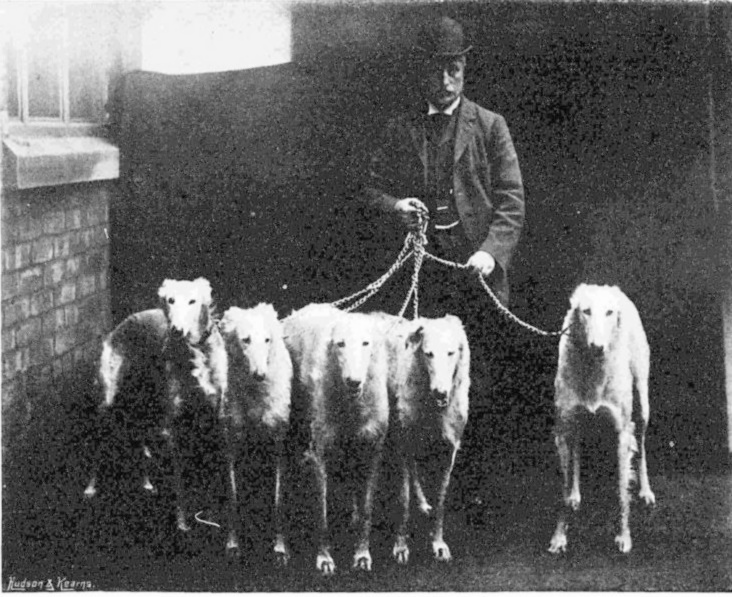
At the same show in Southport, five borzoi from Clumber were present, but not shown. They were an absolute attraction, and by some they surpassed all shown dogs in quality. These were Ooslad, Milka, Golub, Vikhra and Tsaritsa.
12.Tsaritsa (or Tsaretsa) in 1895, colorized photo from the archive of Dan Persson.
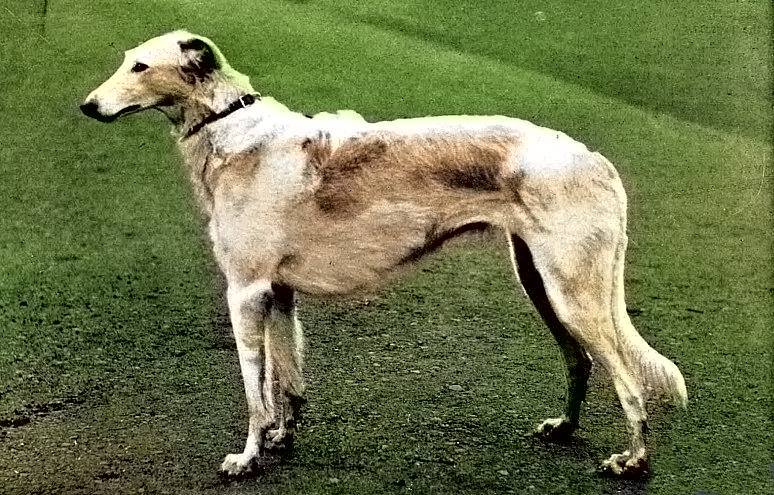
Tsaritsa (1893 or 1895) (or sometimes called Tsaretsa) was most significant among them, considered by many to be the best specimen of the breed ever exhibited at the time. She was a gift to Her Grace from Count Sergei Alexandrovich Stroganoff, an heir to the powerful Russian Family Stroganoff. He was a passionate hunter and one of the founders of the popular Russian hunting magazine Okhota (Hunting). Some sources say that count Stroganoff bought Tsaritsa from the Russian borzoi breeder, General Boldareff. Other say that the Stroganoff could be the breeder of Tsaritsa, as he bought her parents from General Boldareff and they could have a litter at his kennel in 1895. In one of her newspaper articles, the Duchess addresses the count Stroganoff as the breeder of Tsaritsa. Tsaritsa’s brother from the same litter, Marksman, was imported to America by Joseph Thomas at O’Valley Farm. Joseph Thomas is the author of a documentary book about borzoi based on his visits to Russia and the Pershino estate, where the highest quality specimens of this breed were bred. About her, the Duchess wrote: A big bitch of lovely quality, she produced six first prize winners in one litter, and three of them champions, and she herself was unbeaten winner of 200 firsts.
Milka (1889) was first female borzoi champion of Great Britain, gaining the title in 1893. She was bred by Colonel Tschebishoff, same as Nagrajdai II. The Duchess says about Milka: She also, through her daughter Vedma comes into our pedigrees to-day. She is a mixture of her breeds’ Prince Galitzin’s and Visheslavtsov strains – she was pure white.
13.Four borzoi with kill, painter John Emms 1892. © The Kennel Club
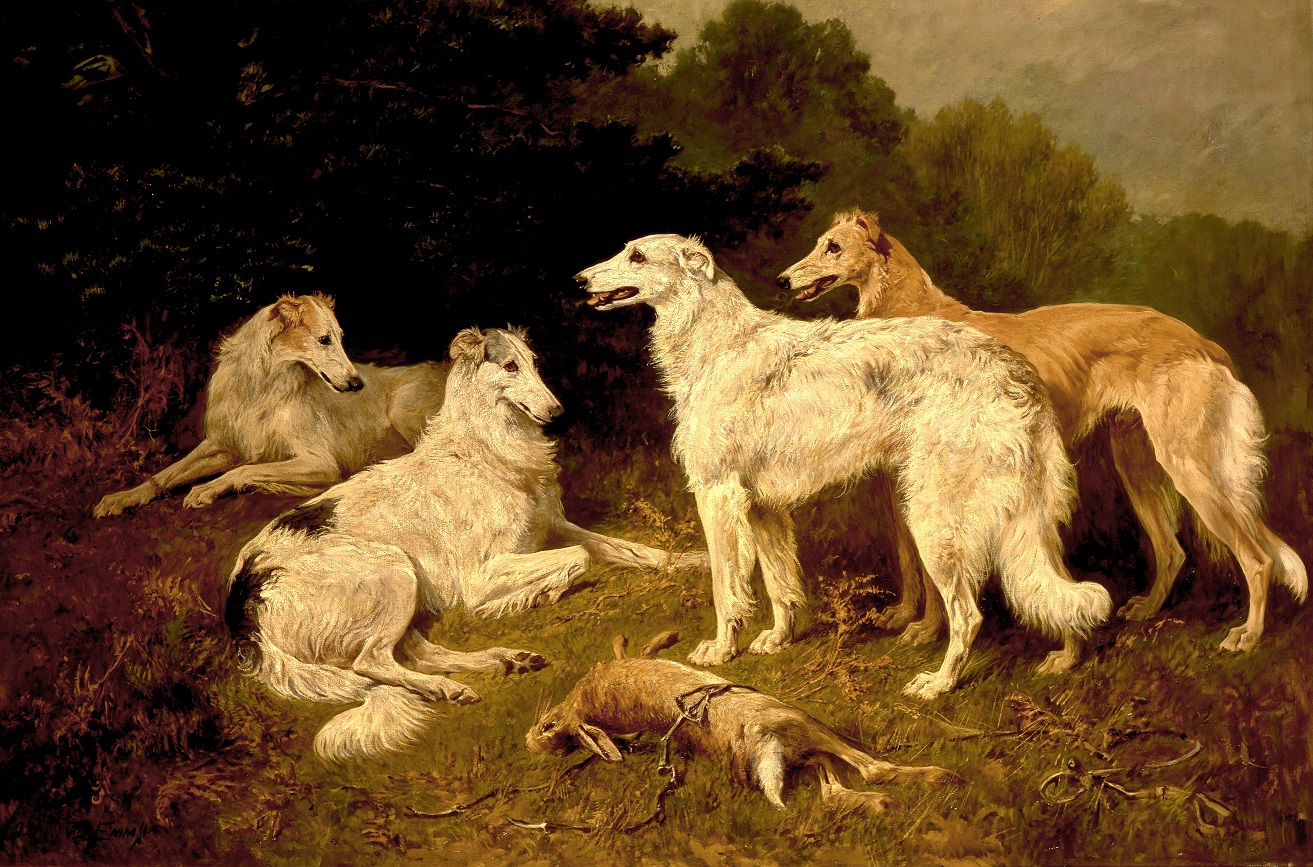
Some of the most important borzoi belonging to the Duchess – Nagrajdai II, Oudar, Golub and Ooslad – are painted on the painting Four borzoi with kill by John Emms. The painting is today owned by The Kennel Club.
Oudar (1888) was bred in the Russian kennel Durassov. He was white with grey markings. Oudar and a dozen other borzoi were sent from St. Petersburg to compete at Crufts in 1892. The Duchess noticed Oudar at the show and bought him for amount of £200, which is today’s value of £30.000. The Duchess writes about him: The best of a large draft sent over by Grand Duke Nicolas, was a big, good coated dog, rather coarse in the head and light in the eye. He did a good deal of winning and sired several winners before I sold him to America.
Nagrajdai II (1888) was purchased by Her Grace from the Russian Colonel Tschebishoff. The Duchess described him as wider in front than any borzoi she had seen, very deep chest, splendid shoulders with straight tail, well let down to the hocks and ‘can go a great pace’.
Ooslad (1887) was a silver medal winner in Moscow, bred by General Sokoloff. About him, The Duchess said: His is perhaps the most dominant blood in our back pedigrees. His sire was Mr. N. A. Boldareff’s Ataman, and his dam was Podruga of Waltsoff strain.
14. Kaissack, Kaissack II and Nagrajdai II

About Kaissack(1888) the Dutchess commented around 1930: His blood comes in present – day back pedigrees through his daughter Vedma, dam of Ch. Vikhra, his sire was bred by Count Sheremeteff, and his dam was of Prince Galitzin and Mr. Korotneff’s blood. I think that he was the best coated Borzoi we have ever had in England, better even that my Ch. Podar is today!
Golub(1889.- 1899.) was bred by the Russian general DimitiWaltzoff, known for the documentary book “Pershino Hunt” in which he describes the Imperial estate and kennels in Pershino, Tula. Golub was immortalized on the painting by artist John Emms, today owned by the Kennel Club. In a German magazine Hunde-Sport und Jagd (Dogs, sport and hunting) from 1893, the dimensions of Golub were stated: height 77.5 cm, chest girth 92 cm, head length 32.5 cm, skull girth 35 cm.Golub died when he was ten years old at the show in Ranelagh Club soon after he got out of his transporter. The newspapers wrote his death was the result of heat, which was unbearable on that summer day. The Duchess wrote about him: A very good dog, wonderfully sound, and a great sire. His blood comes down today.
15. Golub, painter John Emms © The Kennel Club

Borzoi belonging to the Duchess of Newcastle can be also found in the paintings of artist Maud Earl, known for her canine paintings and portraits of dogs that were especially appreciated by Queens Alexandra and Victoria. The painting Borzoi heads by Maud Earl was sold for US$27,500 at an auction in New York in 2013. The painting shows the dogs Vitim (1903), Vassal (1899) and Ivan Turgeneff (1902), all owned by the Duchess of Newcastle.
16.Borzoi heads by Maud Earl © Bonhams
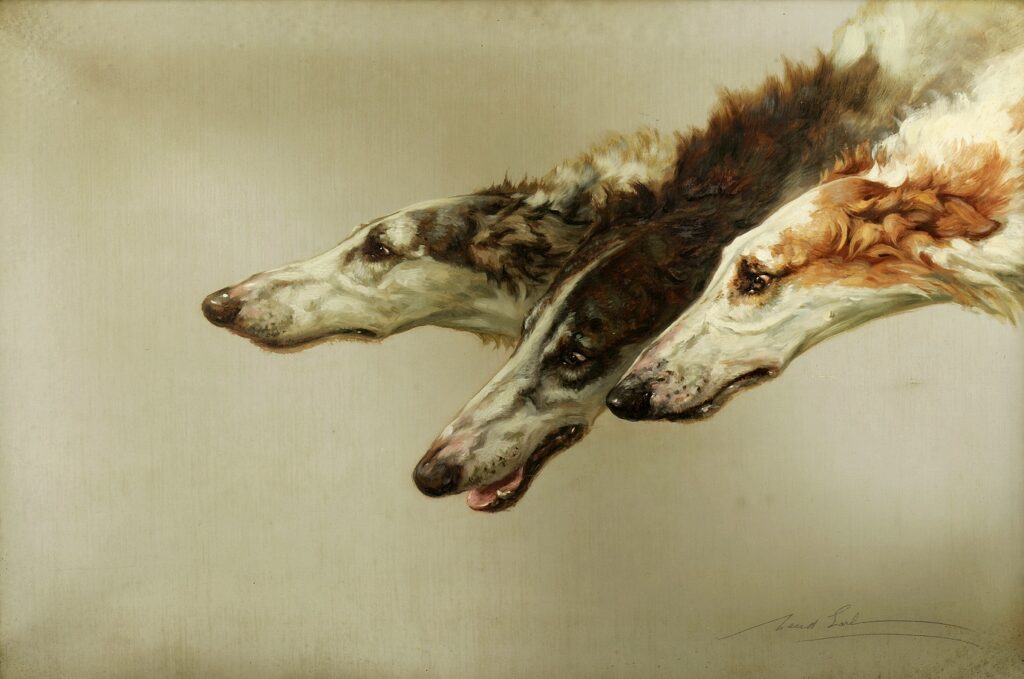
17.Ivan Turgeneffby Maud Earl © Bonhams
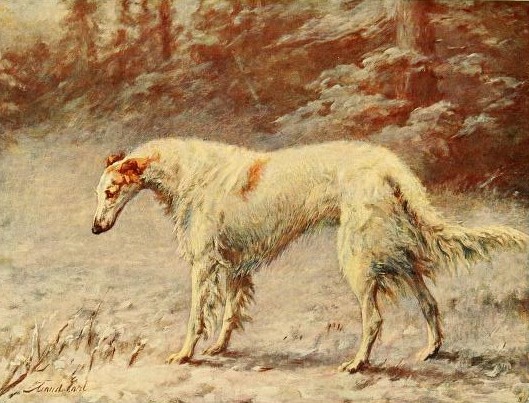
| Head kennel man at Clumber, Mr Gardner, measured following dogs belonging to the Duchess:
Velasquez: height 82.5 cm, head length 32 cm., girth of chest 91.5 cm Velsk: height 79 cm, head length 32 cm, girth of chest 90 cm Tatiana: height 76.5 cm, head length30.5 cm, girth of chest 90 cm Tsaritsa: height 79 cm, head length 30.5 cm, girth of chest 89 cm |
18. Petrosavodsk, son of famous Tsaritsa had all qualities of the breed that we would like to see today “Le Sport UniverselIllustre” 1908.
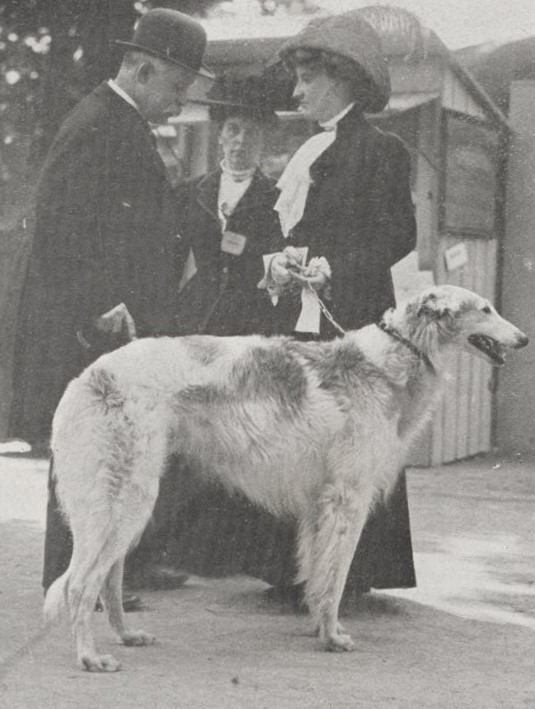
From the Ernest H. Guy collection provided by Sue Vasick, the comments of the Borzoi standard are stated by Her Grace the Duchess of Newcastle in an article for Our Dogs magazine (circa 1930):
Mr George Krehl (editor of the late Stock – keeper), much interested in Borzois during the early nineties of the last century, as who helped so much in the formation of our club, obtained the following standard of points complied by the Russian Imperial Society for the Encouragement of sport, at a meeting held on March 4, 1889 and signed by N. D. Stoopiskin, president, and seven other members of that society. The translation is a literal one, and from it the English Borzoi Club drew up their standard of points on the club’s foundation early in the February of 1892.
Head – Generally lean throughout, with flat narrow skull, leading over a hardly perceptible stop to a long snout. The head, from forehead to end of the nose should be so fine and lean that the shape and direction of the bones and principal veins can be easily seen.
Nose – Black.
Eyes – Dark, expressive, oblong, almond shaped.
Ears – Small, not quite round at the tips, not leathery, set on high, and the tips when thrown back almost touching the occiput.
Neck – Not swanlike, though not short, not rising straight from the withers.
Shoulders – Clean.
Chest – Somewhat narrow, but not hollow.
Back – Rather bony and free from any cavity in the spinal cord (as, from example, is often seen in English Greyhounds) with a well marked arch in the males, but level and broad in the female.
Loins – Broad and drooping.
Ribs – On no account round like a barrel, but flat like a fish, deep, reaching to the elbow, and even lower.
Groin – In the male short, in the female roomy.
Forelegs – Lean and straight, seen from the front they should be narrow, and from the side broad at the shoulder and narrowing gradually down to the foot.
Hindlegs – Should be the least thing under the body when standing still, not straight, and the stifle only slightly bent and the hindlegs not too far apart from one another. Free from dew claws.
Muscles – Those of the hindquarters and shoulders should be long and not convex.
Pasterns – Short.
Feet – Long toes closely jointed together, short and strong nails, and the animal should stand more on the nails than on the heel.
Coat – Soft, long, silky and wavy, and in places somewhat curly. The feet should be covered with hair like a hare.
Tail – Long and sickle shaped.
Note – The male should in general be shorter in body than the female. It should be possible to place the male in a square, so that the withers, toes of forefeet and heels of hindlegs should be placed within the limits of four lines forming it.
The minutes from which the above are extracts are signed by the president and seven other gentlemen.
You will see nothing is said as to color or height, but I will quote Colonel Tschebichoff, who in those days owned the best Borzois dog that had been exhibited (NagrajdaiII – the only Moscow gold medal winner). The colonel says that in his experience he has never seen the front ribs reach as low as the elbow. The dog should have an arched back, and when the bitch is more than ordinarily broad, her back is arched also. There is no greater fault than a back level from the withers, and suddenly arching at the hindquarters. The vertebrae of the spine should be seen like a row of knots. The elbows should never be turned out as they are in a Bulldog. The hocks should be prominent. The hindpart of the body should be broader than the fore. The muscles of the hindlegs should be narrow and long, not as in the English Greyhound broad and thick. Height of dog 25.1/4 inches (64 cm) to 33.1/4 inches (84.5 cm). Height of bitch 22.3/4 inches (58 cm) to 29.3/4 inches (75.5 cm). Average height of dogs 28 inches (71 cm) to 33.1/4 inches (84.5 cm); bitches 24.1/2 inches (62 cm) to 28 inches (71 cm). Coat: on head, the hair short and smooth, the same on ears and front of forelegs. The frill on neck should be long and rather curly. The chest and the rest of the body should be covered with long wavy, but not curly hair. Colour: nose black, eyes very dark although excellent specimens are seen with hazel or some other even lighter colours. Coat should be white, and white with grey spots, white with yellowish –grey spots. Many people object to tiger coloured spots as in the Bulldog.
The Colonel always disqualifies blacks, black and tan, and white with black spots, as he considers that these colours indicate a descent from English or Oriental Greyhounds. His supplementary remarks are valuable. The description of the neck is interesting “not swan like” means not arched. The borzoi carries his neck lower with the head nearer the line of back.
The medals in Moscow are given I suppose much on the same lines as the qualification systems works at other Continental shows. General Boldareff explains this by dividing the different parts into seven, with a maximum of five points to each, making 45 in all. As to the valuation of the points in reference to each other they are placed in this order.
- Hindlegs
- Forelegs
- Ribs
- Back
- General symmetry
- Muzzle, eyes and ears
- Tail
A dog gaining 27 points gets certificate, 30 a bronze medal, 36 a small silver, 40 a large silver and 45 a gold medal. As you can imagine, the gold medal is only given in extraordinary cases. The main things are the working points, the hind legs must be always better than the forelegs.
Of course most of what I have written is very ancient history, but as I was owning and judging Borzois when most of to-day’s owners were barely in their cradles, and I also have had the great privilege of personal instruction of Duke Nicholas Nicolaevich on the points of the Borzoi, I feel that these facts are of interest to Borzoi lovers; and it is as well, too, to realize that although certain well-known Russian owners and breeders did ban black with tan, still dogs of this colour have won at Moscow. Personally I don’t like black markings, as light eyes nearly always follow, still it is only when dogs are equal in all other points that I allow my colour fad to come in.
Signed: K. NEWCASTLE
AN END TO AN ERA
The Duke of Newcastle bought a Forest Farm estate in Winfield near Cranbourne, within Windsor Forest near London where the couple was increasingly staying. The Duchess was dedicated to fox terrier breeding and dog show judging. During 1906, she decided to part with most of her borzoi, except for six of her favourites. She sent the remaining 24 borzoi to the Manchester show where she sold them. This decision was partly of a financial nature, but the second reason was that she primarily decided to continue with the breeding of fox terriers.
After the Duke’s passing in 1928, he was succeeded by his brother, Henry Francis Hope Pelham – Clinton, the VIII. Duke of Newcastle. The dowager Duchess had permanently moved to their Forest Farm estate in Winfield.
19.The Duchess and Podar of Notts at the Forest Farm in Winkfield circa 1930. From the archive of Sue Carter.

20.Painting of Podar of Notts drawn for Her Grace by Miss A. R. Mackinnon, now in a private posession in USA.
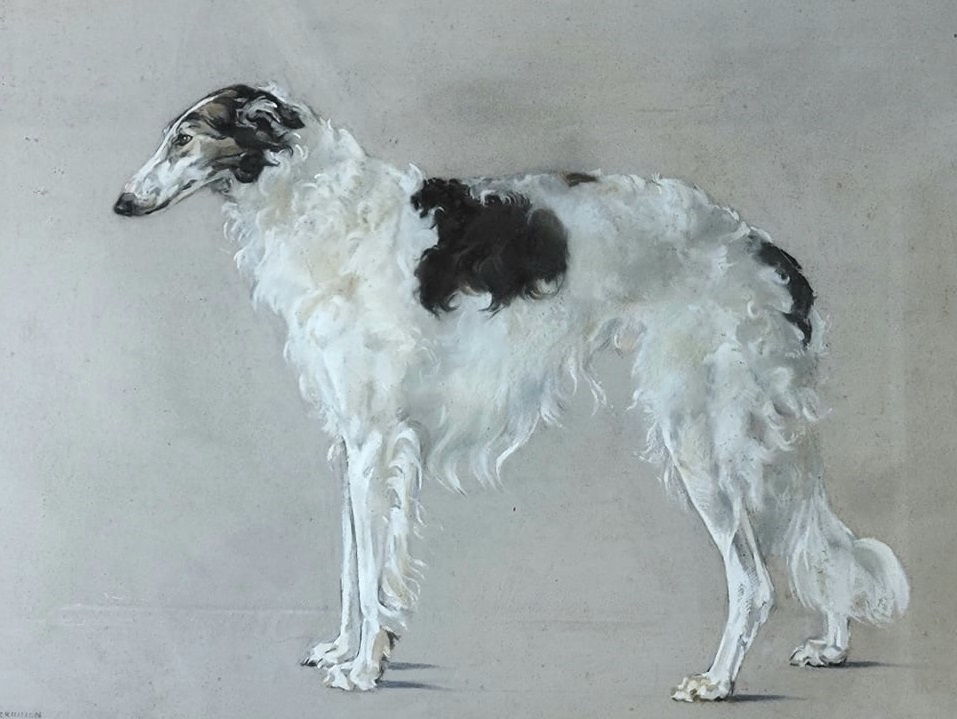
Soon, the new Duke fell into serious financial trouble. The Clumber mansion was demolished in 1938, and the material was sold. Books from the library and all other valuables were also sold. The oak fireplace, adorned with two carved figures of greyhounds was to be moved to the town hall. Unfortunately, during World War II the fireplace was left in a basement where it was attacked by a wormhole and was subsequently destroyed. In the next year, the entire estate was sold for £ 297,500.00 which would be around £20 million in 2021. Clumber Park has been under the protection of the British National Trust since 1946 onwards.
The last show judged by the Duchess of Newcastle was held in 1948., 60 years after the arrival of her first borzoi Spain into her life!
The Duchess passed in 1955. She left her show dogs to her kennel man, and her house dogs to her maid.
21.Kathleen Pelham – Clinton, the Duchess of Newcastle at the coronation of Elizabeth II in 1953.
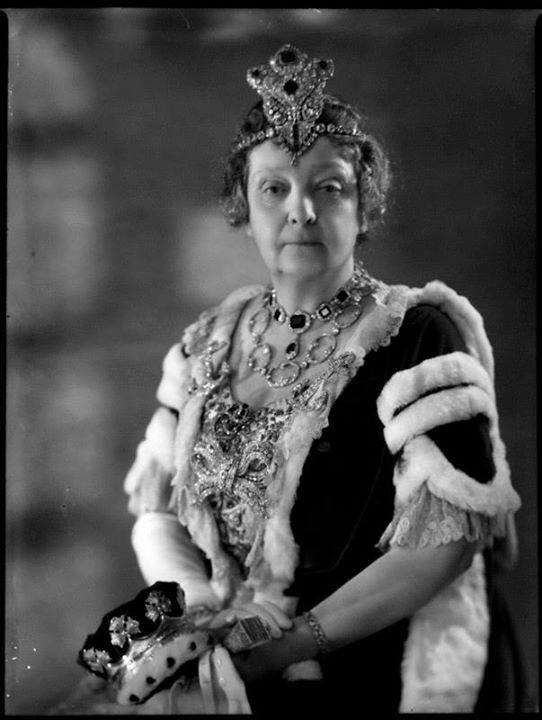
The Duchess was an extremely intelligent woman, with vast experience and a life dedicated to dogs. She deserves to be called and remembered as one of the greatest dog persons in history. Her lines of borzoi are still present in the blood of many champions in United Kingdom, but also in the world. Her influence on the breeding of fox terriers and clumber spaniels is also very significant.
One of the most important breeders of borzoi, Captain Borman, writes about the Duchess in a book British Dogs, Their Points, Selection, And Show Preparationin 1903:
Indeed, in a great measure the borzoi owes its present position in the English dog world to her Grace, who takes a keen and active interest in the welfare of the breed, and who is acknowledged to be the best judge of the variety we have.
22.The Duchess wears a hat with a borzoi motif accompanied by her borzoi Alexandroff of Notts. We can see the missing premolar, often a problem in today’s borzoi. Circa 1933.
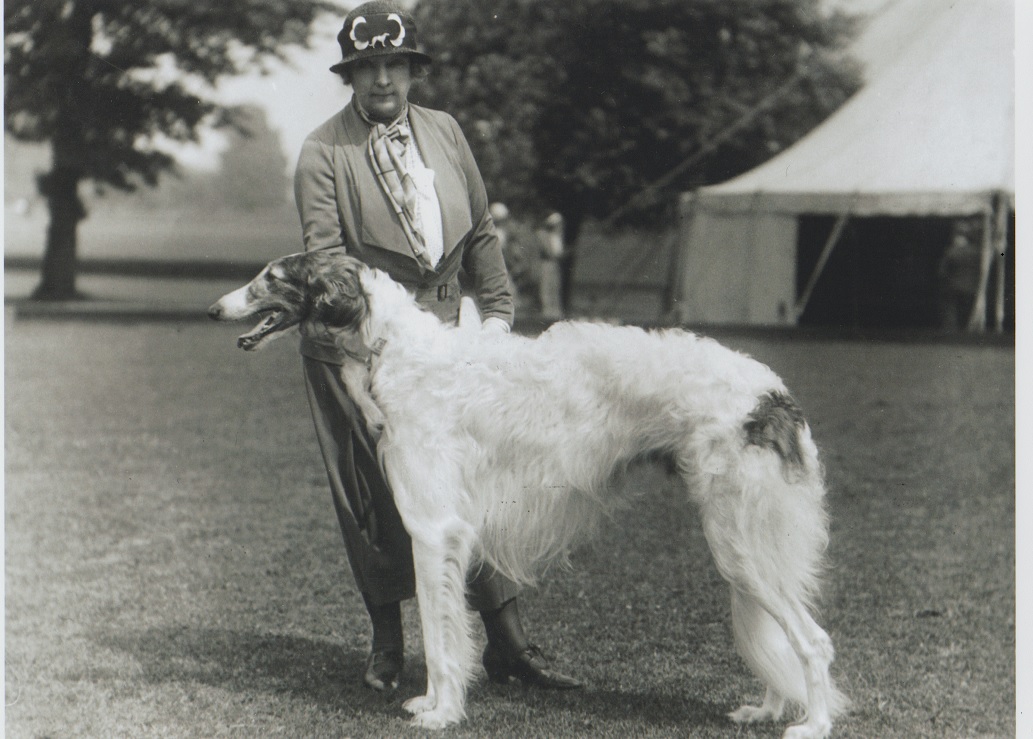
Many thanks to all borzoi friends and members from The Borzoi Encyclopedia that helped in creation of this article.
Literature:
Ornament of Sherwood Forest, John Fletcher, Country Books, 2005.
РусскиепсовыеборзыенаЗападе. Начало., ИринаШлыкова, АндрусКозлов, 2013.
Dog shows and doggy people, C. H. Lane, Hutchinson & co., London 1902.
History and Description of the Modern Dogs of Great Britain and Ireland, Vol 1 & Vol. 2, Rawdon B. Lee, London 1897.
British Dogs, Their Points, Selection, And Show Preparation, W. D. Drury. 1903, Charles Scribner’s Sons
Kennel secrets: How to breed, exhibit, and manage dogs, Perry, Joseph Franklin, 1846.
The Borzoi, Desiree Scott, Kingdom Books, 1999.
The modern borzoi, Valeska borzoi Rey and Yvonne McGehe 2002.
Sue Vasick’s archive, Ernest Guy collection
The ilustrated sporting and dramatic news, 29.01.1898.
Country Life Illustrated, 17.06.1899.
www.wirefoxterrierassociation.co.uk
BONUS – PEDIGREES
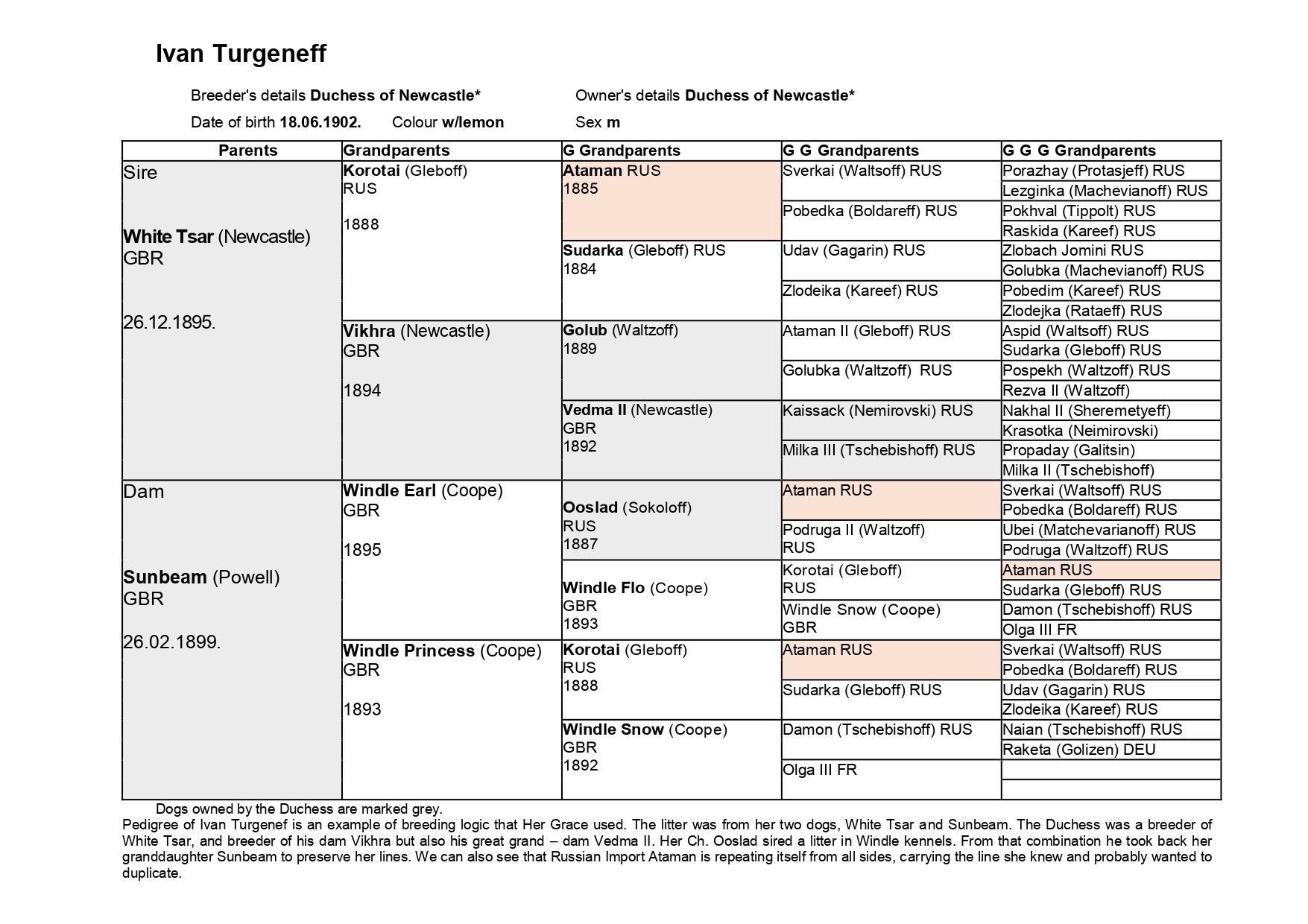

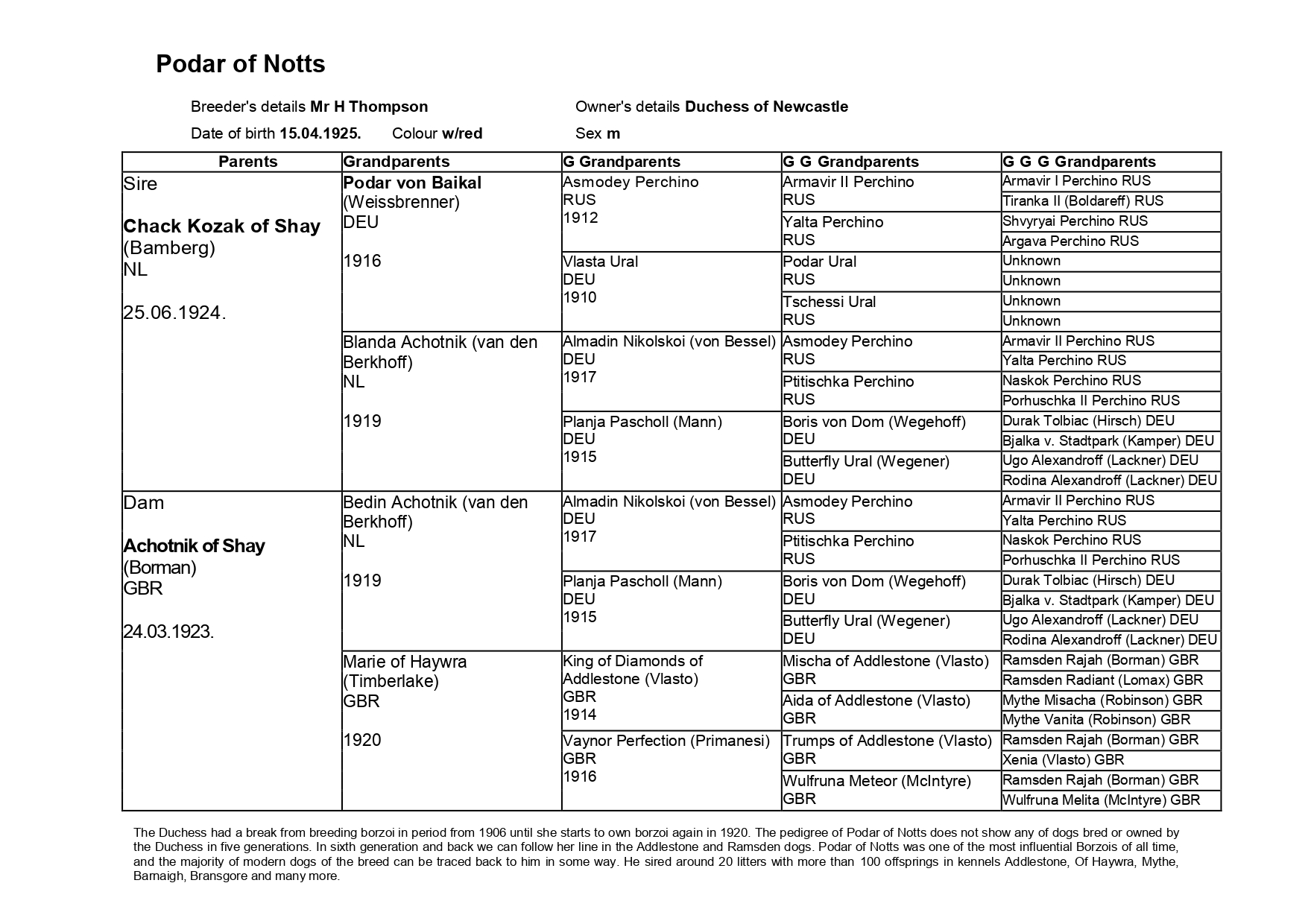
Year of Event:
Country:
Personal Collections:
Source:
Author:
Dogs:
Persons:
